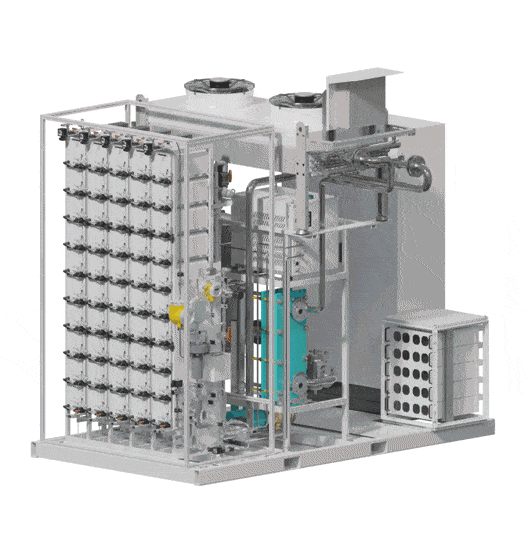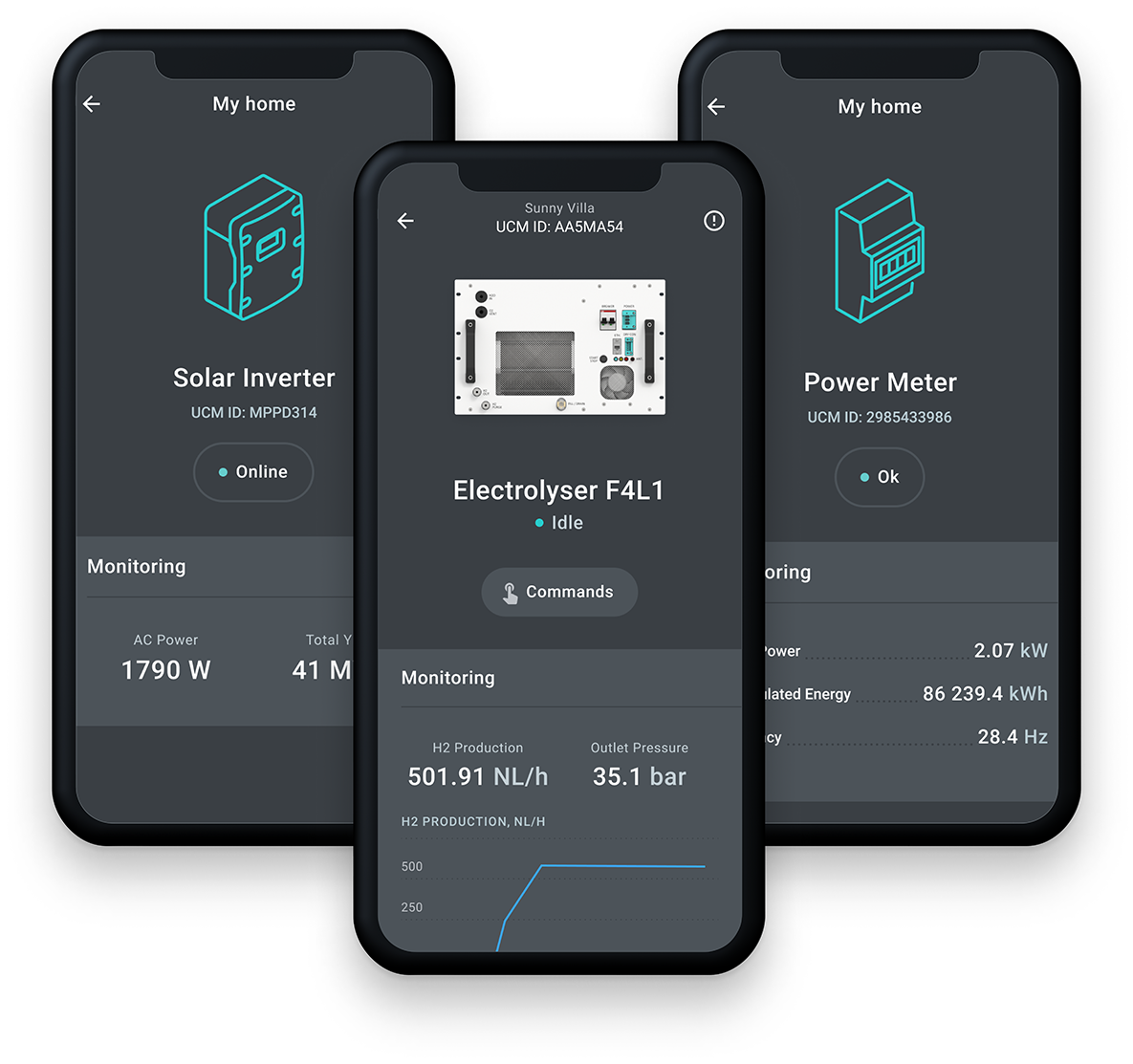Enapter AEM Flex™ 120: The electrolyser fitting your production needs
Our Enapter AEM Flex™ 120 enables your streamlined launch of green hydrogen in pilots ranging from industrial process heat to refueling.
The Enapter AEM Flex™ 120 system, with a capacity of 120 kW, offers operational flexibility ranging from 12% to 100% of the nominal H2 flow rate, allowing for adjustment based on power availability or hydrogen production demands. Featuring built-in redundancy and automated remote operation via an Energy Management System, the Enapter AEM Flex™ 120 presents an optimal solution for on-site hydrogen production with minimal maintenance requirements. By combining up to 4 individual Flex 120 units, a total power range of 14.4 kW to 480 kW can be achieved, capable of producing up to 215 kg of H2 in a 24-hour period.
What is Enapter’s AEM technology, and how does it work?
Enapter’s core product is the standardised and stackable anion exchange membrane (AEM) electrolyser.
Electrolysers use electricity to split water (H2O) into hydrogen (H2) and oxygen (O2) through an electro-chemical reaction. The stack is the electrolyser’s heart and comprises multiple cells connected in series in a bipolar design. Enapter’s unique technology is the design and operation of these cells, consisting of a membrane electrode assemble (MEA), made from a polymeric AEM and specially designed low-cost electrodes. The anodic half-cell is filled with dilute KOH (alkaline) electrolyte solution; the cathodic half-cell has no liquid and produces hydrogen from water permeating the membrane from the anodic half-cell. Oxygen is evolved from the anodic side and transported out from the stack through the circulating electrolyte. The hydrogen is produced under pressure (typically 35 barg) and is already extremely dry and pure (about 99.9%). Using Enapter’s ancillary dryer module, hydrogen is delivered at 99.999% purity.

The modular design – paired with advanced software integration – allows set up in minutes and remote control and management. Stack this electrolyser to achieve the required hydrogen flowrate.
The AEM stack module
The AEM stack module is the centerpiece of the product platform, minimum modular unit (MMU). It is equipped with the necessary sensorsto measure flow speeds,
temperatures and pressures. This enables detailed and granular monitoring of the state of health of each stack, as well as optimization of overall system management to balance running times and schedule preemptive
maintenance activities. Gas and water connectors are easily accessible at the front. Electric connectors are in the back.
What is the difference between the Proton Exchange Membrane (PEM) technology and the Anion Exchange Membrane (AEM) technology, and what are the advantages of AEM?
Proton exchange membrane electrolysers (PEM) use a semipermeable membrane made from a solid polymer and designed to conduct protons. While PEM electrolysers provide flexibility, fast response time, and high current density, the widespread commercialisation remains a challenge primarily due to the cost of the materials required to achieve long lifetimes and performance. Specifically, the highly acidic and corrosive operating environment of the PEM electrolyser cells calls for expensive noble metal catalyst materials (iridium, platinum) and large amounts of costly titanium. This poses a challenge to the scalability of PEM electrolysers.
The anion exchange membrane electrolysers use a semipermeable membrane designed to conduct anions. They are a viable alternative to PEM with all the same strengths and several key advantages that lead to lower cost. Due to the less corrosive nature of the environment, steel can be used instead of titanium for the bipolar plates. Furthermore, AEM electrolysers can tolerate a lower degree of water purity, which reduces the input water system’s complexity and allows filtered rain and tap water.
Enapter AEM Flex™ 120 green hydrogen applications
- Extremely high availability and built-in redundancy
- Automated & remote operation with our EMS by Enapter
- Ideal for on-site hydrogen production
- Low maintenance requirements
Downloads
Specifications
Hydrogen outlet temperature:
5 -55 °C
Hydrogen output purity:
99.95% in molar fraction,
equals dew point of -30 °C
lmpurities: H₂O < 500 ppm, O₂ < 5 ppm
Hydrogen purity with optional dryer:
99.999% in molar fraction,
equals dew point of -65 °C
lmpurities: H₂O < 5 ppm, O₂ < 5 ppm
Output pressure:
up to 35 barg
Hydrogen nominal flow:
25 Nm³/h
53.9 kg/24h
Netvolume flow rate
Nominal power:
120 kW Beginning of life (BOL)
Consumption:
150 kW
Near end of life (EOL)
Voltage:
3 x 400VAC, ±10 %
Frequency:
50/60 Hz, ±10 %; THD < 5%
Water nominal consumption:
23 L/h Purified water
Dimensions:
L: 3.2 m x W: 2.5 m x H: 3 m
Water inlet temperature:
5 -55 °C
1- 4 barg
Water inlet quality:
Minimum ASTM D1193-06 Type IV or recommended Type II or Type III¹
Operational flexibility:
12 %-100 %
Of nominal H₂ flowrate
Turndown ratio:
8:1 Maximum flow/Minimum flow
Specific power consumption (Efficiency) +:
4.8 kWh/Nm³ H₂
53.3 kWh/kgH₂
62.5% (LHV)
lncluding all utilities inside the battery limits of the AEM Multicore (at BOL)
Hot startup time:
0 – 100% in 100 seconds
Electrolyte is at min. 35 °C
Cold startup time:
0 – 100% in 30 minutes
Assuming 5 °C ambient temperature
Shut down time:
100 – 0% in 3 minutes
Normal, gradual shut down
Hot standby power consumption:
20 kW Max.
Stacks are hydrated and electrolyte circulates at min. temperature (35 °C)
Type of installation:
lndoor
5 – 35 °C
Process heat output:
35 kW
BOL; ~ 50 °C
Transport dimensions:
Fits inside 20 ft high cube container
Weight:
~ 3,700 kg
Request for a quote
Send us a short message, if you are interested in this module and we’ll get back to you as soon as possible.















